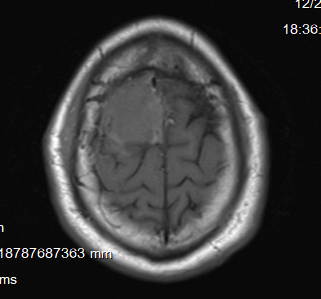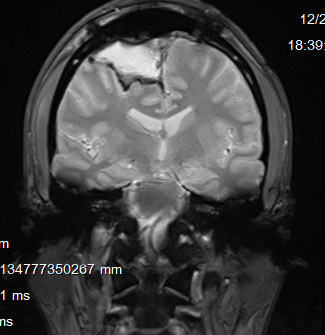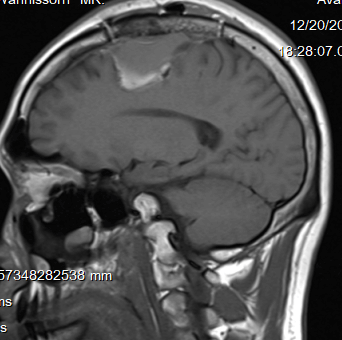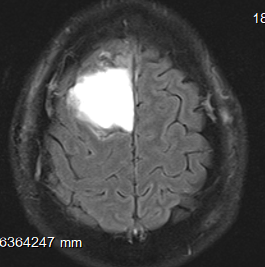
Brain tumours
The silent killer
Sukumvit Hospital employs advanced techniques to reduce blood loss during brain surgery.
In the case of a recent patient who visited Sukumvit Hospital, a passing headache ended up being a serious condition. The patient, a 40 year old man named Khun Chatra, had a history of headaches but at the end of last year, his frustrations grew when he experienced a severe headache on Father’s Day, with painkillers and regular meals proving ineffective against the pain. Worried about the severity, Khun Chatra consulted with a friend who is a doctor to understand the root cause for the persistent headache. He then decided to visit Sukumvit Hospital, where doctors did a routine examination followed by an MRI that scans the brain using electromagnetic waves. The results showed that the patient had a large tumour, initially believed to be five centimetres in size, in the right side of his brain. The medical team who examined the patient agreed that surgery was necessary to treat the tumour as it was very large. Due to the size, the tumour was likely pressing on key areas of the brain, causing complications. Two doctors specialising in neurology, Dr. Jackree Thanyanopporn, specialist in Neurosurgery and Interventional Neuroradiology and Dr. Juksanee Thanyanopporn, doctor of Neurology, made it clear that there was no choice but to operate.
Dr. Jackree describes the condition of the patient…
“Khun Chatra came to the hospital with a headache. On the day we examined him, we saw that he had severe headache symptoms and his hands trembled but he did not have any weakness. When we ordered the MRI, it was found that he had a brain tumour that was pressing on the right side of his brain that controls limbs, resulting in his left hand tremouring. Afterwards, it was communicated to the patient that the condition puts him at risk of a left hemisphere paralysis and there is the chance of blood loss, loss of memory function, convulsions, and other complications.”
Dr. Jackree describes the condition of the patient…
“Khun Chatra came to the hospital with a headache. On the day we examined him, we saw that he had severe headache symptoms and his hands trembled but he did not have any weakness. When we ordered the MRI, it was found that he had a brain tumour that was pressing on the right side of his brain that controls limbs, resulting in his left hand tremouring. Afterwards, it was communicated to the patient that the condition puts him at risk of a left hemisphere paralysis and there is the chance of blood loss, loss of memory function, convulsions, and other complications.”
Dr. Juksanee Thanyanopporn
After Dr. Jackree saw the diagnostic images, he evaluated that it was a benign tumour and not a malignant tumour, but because of its large size it had the potential to cause blood loss during surgery. To begin the process, the doctor injected dye into the bloodstream, then employed a technique called catheter angiography embolisation, a minimally invasive treatment that blocks the blood vessels to reduce blood flow to an area. Dr. Jackree explains, “Tumours are alive, therefore they can draw new blood vessels. By implementing a catheter angiography embolisation, we can stop this from happening and subsequently reduce blood loss during surgery. This process begins with a close study of MRI results, checking the body’s vitals once again, and then using what is called a ‘Navigator,’ a visual imaging programme that can determine what is needed during the surgery, including preparing the operation room, what incisions are required and what should be avoided, and what to do to ensure no mistakes happen.” Dr. Jackree also explains why the catheter angiography embolisation procedure is beneficial for patients like Khun Chatra: “Patients who are of older age are at risk of blood loss during an operation because the heart will work hard during surgery, which can result in complications like an acute heart attack. The biggest benefit of reducing blood loss through a catheter angiography embolisation is that the patient is safe during the surgery. Although this technique can be used to treat tumours, it is important to consider where the vessels will be occluded, as some locations are not possible. “Brain tumours are a kind of disease that you will never be sure of unless you get tested or unless you have defining symptoms. Many patients in Thailand will wait until they have limb weakness to get an X-ray, then further tests are needed to be determined whether the tumour is benign or malignant. A patient’s medical history is also important, particularly whether they have other diseases or cancers as it adds to the chance of it spreading to the brain. It is imperative to get examined straight away if you suspect a tumour. “Symptoms of a brain tumour differ depending on its location and size. In the case of Khun Chatra, he suffered from headaches, and trembling hands but some people can have numbness, fainting, limb weakness, blurred speech, double vision, and hiccups. Many of these symptoms are similar to stroke. Therefore, finding the root cause it is important so that it can be determined if the tumour is good or bad, and what kind of treatment to seek. A follow-up 3-6 months after is also crucial for reducing the chance of recurrence.”
The patient, Khun Chatra, reflects on the entire treatment process and surgery…
“After listening to an explanation from the doctor, I understood that the risks were quite big with chances of disability and death. But thanks to Dr. Jackree, Dr. Juksanee, and the hospital staff, I was able to make a fast recovery. If you look back on my timeline, I arrived on Dec. 7th. By Dec. 8th we had a plan, Dec. 9th the doctor performed the catheter angiography embolisation, Dec. 10th I rested in the ICU, and on Dec. 11th I underwent brain surgery. Despite being a big procedure, I woke up within half an hour after the anaesthesia wore off. I was able to talk to relatives and the doctor, and was thrilled to have been able to recover quickly. When I think about how I was able to recover, I believe it is a combination of the doctors’ talent and skill and the level of service the hospital were able to provide me. They took very good care of me during my 17 days there.”










